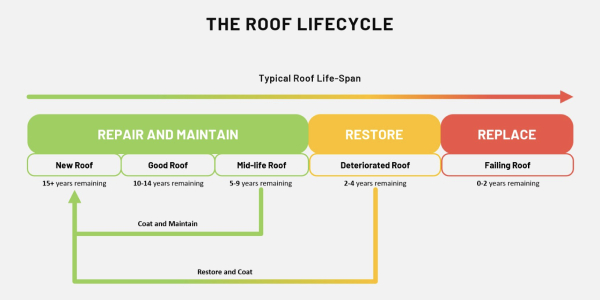UP TO THE MINUTE
Green, orange, red: Which restoration level is your roof at?

By Emma Peterson.
Learn how to identify whether a roof is ready for restoration or in need of replacement.
Roof coating restorations are growing more common and popular because they can lower costs and maintenance for both building owners and contractors. But not every roof is a good fit for a restoration, some need the investment of an entire replacement to maintain integrity and performance. In this CoatingsTalk webinar, Heidi J. Ellsworth spoke to Chris Huettig of KARNAK about the way they evaluate roofs for restoration using their three-color lifecycle of a roof chart.
Green level
On the far left in the green of the chart is a new roof. The green then extends to the right, encompassing the first ten years of a roof’s life. This is when the focus is not on restoration or replacement, but repairs. Chris explained, “The roof itself is an asset to a building owner. So if you think about that, on a building owner's balance sheet, they want an asset to remain there and they want that roof to be maintained to be an asset for that company.”
For this part of the roof’s lifecycle, Chris recommends biannual maintenance checks, which includes “inspecting the roof, cleaning out drains and scuppers, putting new caulking where that needs to be placed as it wears down and all those good things that we do on our proactive maintenance contracts.” This is key to extending the lifespan of the roof and saving the owner money in the long run. But eventually, no matter how well maintained a roof is, time will cause it to wear down and it will move into the orange phase of its life.
Orange level
Roofs can enter this level either because they have not been maintained properly, or because the environment has simply worn them down over a decade. This is what Chris and KARNAK call the restore phase. He elaborated, “Roofs in the orange phase are starting to not be an asset for that building owner and we want to help them get that roof back to being an asset.”
To help improve a roof during this phase, Chris recommends considering redoing the foundational parts of the coating. He shares, “It may not just be a reflective coating, maybe we need to put down some kind of a base and a full fabric to give it a good foundation to then put that reflective coating on top.” This is a critical moment in a roof’s lifespan to save the building owner a large amount of money by avoiding a replacement. And it’s really important for contractors to take this moment to help clients understand their option. Chris explained, “It's a great time to get them what they need but also to educate them as well and understand they do have choices. They don't have to let that roof just completely fail.”
Red level
But, no matter how much work is put into a roof, it will eventually reach the far right of the chart and the red phase of its lifespan. This is marked by when a roof is no longer an asset to the building owner but a liability. Chris explained, “They're going to have to add money and fix that roof before they sell it. And no building owner wants to be in that position. So our job as contractors and manufacturers is to help building owners to stay on that left side to be in that repair and maintain levels.”
There are many reasons a roof might get classified in the red, but the common cause is water intrusion in the roof and the insulation. Roofs at this phase in their life are not candidates for restoration and instead need to be replaced. Chris explained, “If you're on a roof that's in the red zone, really the only thing that you can do at that point, I call it roof triage, and it's just kind of your band-aid repairs here and there, but letting the building know, ‘Hey, I'm going to do something here because it looks like this. What I'm doing, is not going to last very long. You really need to think about a new roof, and I'll put a plan together to re-roof this for you.’”
Read the transcript, Listen to the episode or Watch the full webinar for about roof coating restorations!
Learn more about KARNAK Reflective Coatings, Sealants and Cements in their Coffee Shop Directory or visit www.karnakcorp.com.
About Emma
Emma Peterson is a writer at The Coffee Shops and AskARoofer™. Raised in the dreary and fantastical Pacific Northwest, she graduated in 2024 from Pacific University in Oregon with a degree in creative writing and minors in graphic design and Chinese language. Between overthinking everything a little bit, including this bio, she enjoys watching movies with friends, attending concerts and trying to cook new recipes.



















Comments
Leave a Reply
Have an account? Login to leave a comment!
Sign In